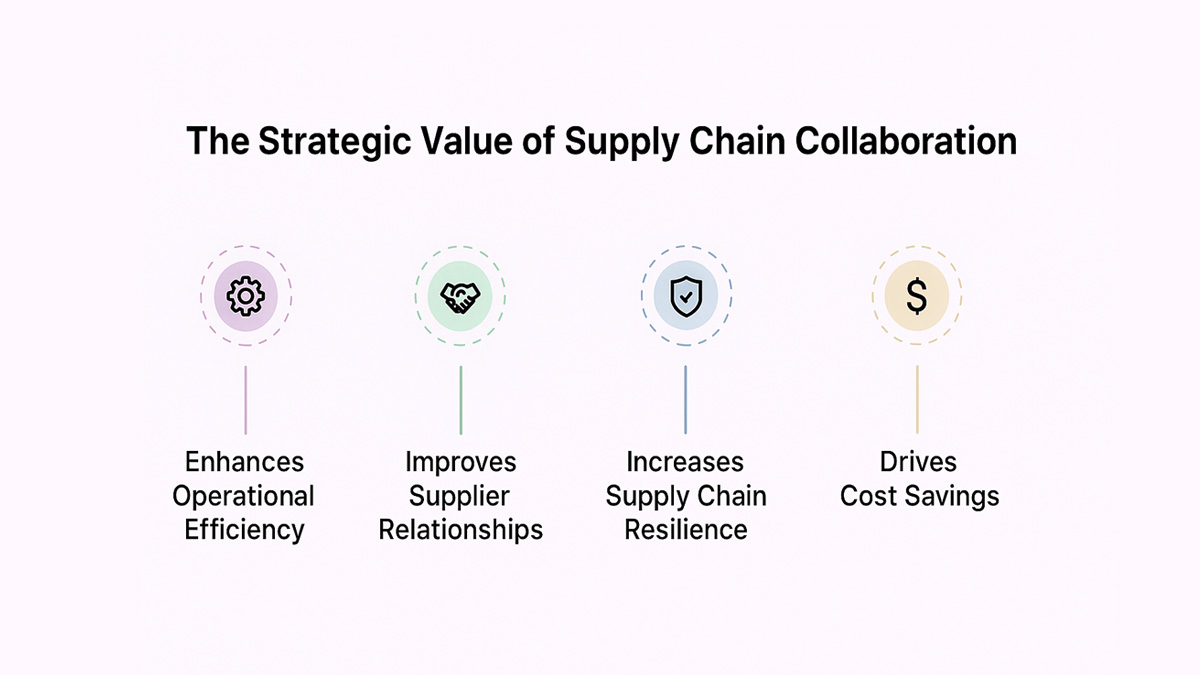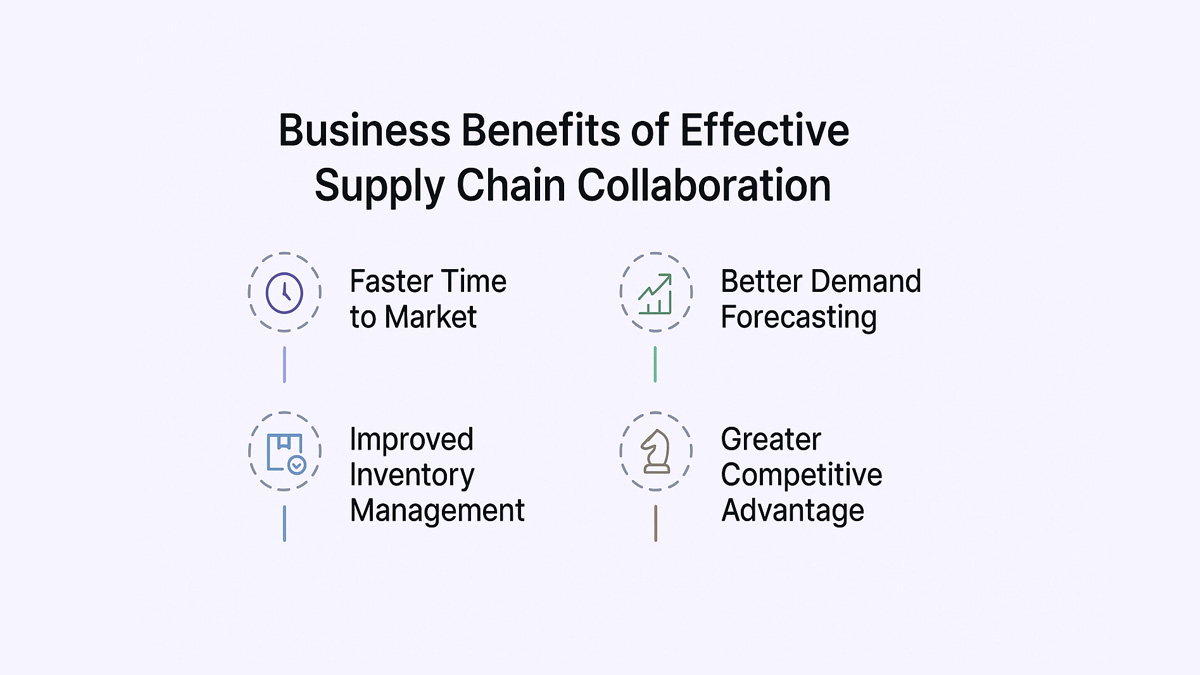

4 Types of Supply Chain Collaboration That Drive Efficiency

4 Types of Supply Chain Collaboration That Drive Efficiency
Learn the four key types of supply chain collaboration that drive efficiency, reduce costs, and improve vendor partnerships.


In today’s fast-paced economy, supply chains don’t operate in silos anymore - they thrive on collaboration. When different players across the value chain work in sync, it’s like a well-rehearsed orchestra: smooth, efficient, and impactful. Whether it’s manufacturers syncing with suppliers or retailers partnering with logistics providers, collaborative supply chains are proving to be a game-changer in cutting costs, boosting speed, and improving resilience. Effective Supply Chain Management plays a vital role in ensuring that these collaborations deliver measurable results across the value chain.
What this blog covers:
- What is supply chain collaboration?
- Why is supply chain collaboration important?
- Types of supply chain collaboration
- Benefits of effective supply chain collaboration
- Common challenges in supply chain collaboration
- How Spendflo helps with supply chain collaboration
- Frequently asked questions on supply chain collaboration
What is Supply Chain Collaboration?
Supply chain collaboration refers to the strategic alignment and joint efforts of various supply chain partners - such as suppliers, manufacturers, distributors, and retailers - to achieve shared goals. This collaboration enhances visibility, reduces inefficiencies, and drives mutual value across the supply chain.
Why is Supply Chain Collaboration Important?
When companies collaborate across the supply chain, they’re not just sharing resources - they’re multiplying value. A well-coordinated supply chain can make the difference between a business that just survives and one that thrives.
Here are the reasons why supply chain collaboration is important:

Enhances Operational Efficiency
When all partners - from procurement to delivery - are on the same page, operations flow more smoothly. Information-sharing eliminates guesswork and delays, reducing cycle times and improving responsiveness. This approach promotes improved efficiency across procurement, logistics, and distribution functions. Instead of waiting for approvals or updates, teams can act fast with real-time data at their fingertips.
To understand the complete differences between procurement & supply chain management, read "What Is The Difference Between Procurement and Supply Chain Management".
Improves Supplier Relationships
Strong partnerships lead to better negotiations, longer-term contracts, and more favorable terms. This shared commitment also leads to consistent product quality that meets end-customer expectations. Suppliers become more than vendors - they become strategic allies. With mutual trust in place, both sides are more willing to share insights and explore innovation together.
Increases Supply Chain Resilience
Collaborative supply chains are more adaptable during disruptions. By integrating proactive risk management strategies, businesses can anticipate potential bottlenecks before they escalate. Whether it’s a raw material shortage or a logistics breakdown, shared data and open communication help identify problems early and allow for coordinated responses. This agility can significantly reduce the impact of external shocks. During events like supply chain disruptions, this coordinated resilience ensures faster recovery and minimal downtime.
Drives Cost Savings
Working together allows companies to streamline processes and remove redundancies. Joint forecasting, bulk purchasing, and shared logistics reduce procurement and transportation costs. These collective efforts ultimately drive substantial cost reductions while enhancing profitability. Over time, this translates to major financial gains and improved profit margins.
Now that we’ve seen why collaboration matters, let’s look at the different ways it can take shape.
Types of Supply Chain Collaboration
Not all collaboration is created equal. Depending on the business goals and stage of the relationship, companies may collaborate in different ways - each offering distinct advantages. In the modern supply chain, success depends on how seamlessly partners can align their goals and share data.
Here are four key types of supply chain collaboration:
Strategic Collaboration
This is a long-term, high-impact form of collaboration where companies align on shared goals and strategic initiatives. It often involves joint investments, co-innovation, and integrated planning. Think of automotive giants and their Tier 1 suppliers co-developing new technologies - that’s strategic collaboration in action.
Operational Collaboration
At this level, the focus is on improving day-to-day activities such as demand forecasting, inventory planning, and production scheduling. By sharing operational data, companies can align their processes, reduce lead times, and avoid stockouts or overproduction. This transparency offers enhanced visibility into every stage of production and delivery. It’s the nuts and bolts of getting things done together.
Tactical Collaboration
Tactical collaboration sits between strategic and operational efforts. It typically involves aligning on short-to-medium-term goals - like managing seasonal demand, launching a new product, or optimizing a specific route or region. These agile responses also help businesses stay competitive amid constant market changes. It’s goal-driven, flexible, and often time-bound.
Technological Collaboration
In today’s digital-first world, tech-enabled collaboration is essential. This involves integrating systems, sharing platforms, or using cloud-based tools for real-time data exchange. For example, using a shared procurement system or collaborative logistics dashboard can dramatically boost visibility and speed across the chain. Real-time data sharing further ensures that every stakeholder can make quick, informed decisions.
Benefits of Effective Supply Chain Collaboration
When collaboration clicks, the ripple effects are powerful - and measurable. Beyond smoother operations, effective collaboration unlocks tangible advantages across business performance, customer satisfaction, and bottom-line results. The benefits of supply chain collaboration extend beyond cost savings to include long-term value creation.
Here’s what businesses gain from strong supply chain partnerships:

Faster Time to Market
Collaborative planning allows companies to move from idea to delivery more quickly. When suppliers and manufacturers coordinate on demand forecasts and production timelines, new products reach shelves or customers sooner - giving companies a vital edge in competitive markets.
Better Demand Forecasting
Sharing historical sales data, market trends, and real-time inventory levels across the supply chain makes demand forecasting more accurate. Instead of relying on siloed projections, businesses gain a full-spectrum view - reducing guesswork and aligning production with actual market needs. This precision helps businesses meet fluctuating market demands more accurately and efficiently.
Improved Inventory Management
When partners coordinate procurement and restocking activities, they can reduce excess inventory and avoid costly stockouts. Real-time insights into supplier capabilities and lead times help maintain the right inventory at the right time - minimizing holding costs and enhancing cash flow. Leveraging predictive analytics can further optimize stock levels and reduce inventory risks.
Greater Competitive Advantage
Collaboration fosters innovation. Whether it’s co-developing sustainable packaging with vendors or building flexible logistics solutions with 3PL partners, working together often leads to smarter, customer-centric offerings. These innovations translate into brand differentiation and long-term competitiveness. They also contribute to better risk mitigation through smarter planning and diversification.
Now that we’ve looked at the upside, it’s equally important to understand what might hold collaboration back - and how to tackle those roadblocks.
Common Challenges in Supply Chain Collaboration
Collaboration sounds great on paper - but it’s rarely without friction. Many businesses run into hurdles when trying to align with partners who may have different priorities, systems, or operating styles.
Here are some of the common roadblocks:
Lack of Data Visibility
When data isn’t shared - or is shared too late - it slows down decision-making. Without transparency on inventory levels, shipment status, or procurement cycles, partners are left to make assumptions, leading to delays and inefficiencies.
Misaligned Goals Across Partners
Suppliers might be optimizing for volume, while buyers are focused on just-in-time deliveries. Without aligned KPIs or shared success metrics, collaboration efforts can quickly drift. Misaligned incentives often lead to finger-pointing when challenges arise.
Technology Integration Issues
Partners may use different software systems, making data exchange clunky or manual. Without API integrations or shared platforms, collaboration becomes a time-consuming process riddled with human errors and delays.
Communication Breakdowns
Even with the right tools, poor communication can derail collaboration. Ambiguous roles, delayed responses, or cultural misalignment between teams can weaken trust and slow down progress. Consistent, clear communication protocols are essential. Establishing these habits fosters an agile supply chain capable of adapting quickly to change.
Let’s now look at how Spendflo helps bridge these gaps and foster effective supply chain collaboration.
How Spendflo Helps with Supply Chain Collaboration
Spendflo empowers finance and procurement teams to work more effectively with vendors by centralizing visibility, automating renewals, and aligning spend with business priorities. With shared dashboards, real-time contract insights, and proactive alerts, teams avoid surprises and stay in sync. By reducing manual processes and surfacing negotiation benchmarks, Spendflo helps build trust and transparency - cornerstones of great collaboration.
Frequently Asked Questions on Supply Chain Collaboration
What are the most effective types of supply chain collaboration?
Strategic and operational collaborations are often the most impactful. Strategic efforts align long-term goals, while operational collaborations optimize daily activities like inventory and production planning.
How do you overcome common challenges in supply chain collaboration?
Start by aligning KPIs, improving communication, and investing in shared technologies. Regular check-ins, transparency, and trust-building also go a long way in overcoming misalignment and friction.
Can technology improve collaboration across the supply chain?
Absolutely. Tools like shared dashboards, cloud-based ERPs, and procurement platforms improve visibility, reduce errors, and make it easier to coordinate actions across partners.
What are some examples of successful supply chain collaboration?
Joint product development between automotive OEMs and suppliers, shared forecasting systems in retail, and coordinated logistics between manufacturers and 3PLs are all strong examples of collaboration in action.










.png)




.png)










.avif)





